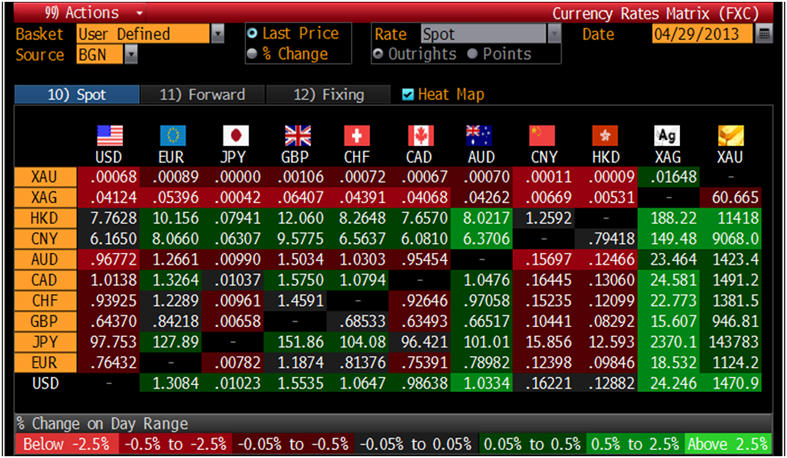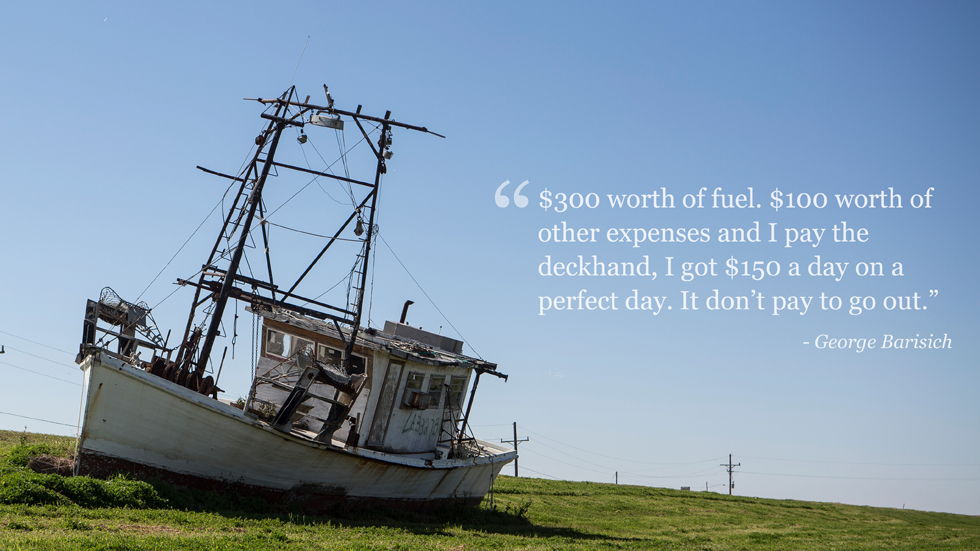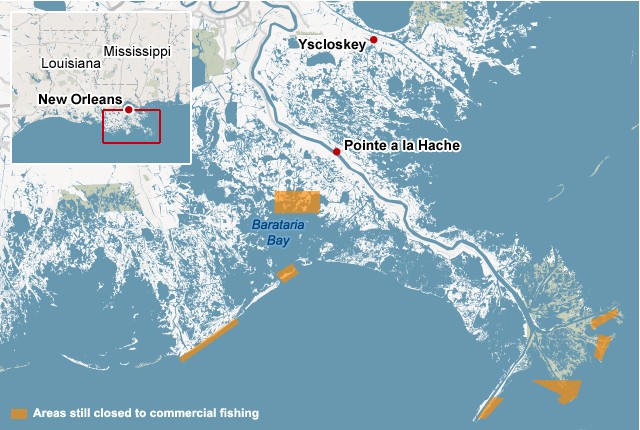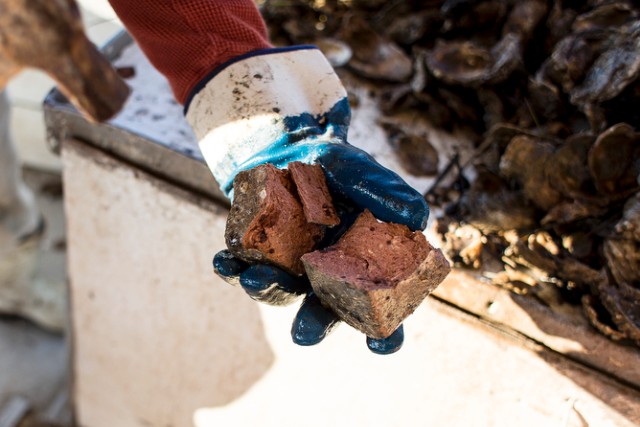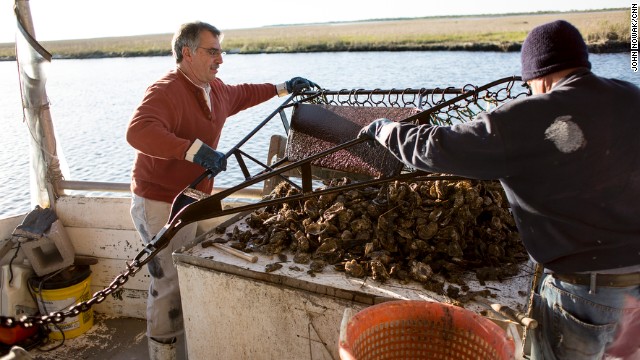STORY HIGHLIGHTS
- Saturday marked three years since the Gulf oil disaster erupted
- Since then, Louisiana's statewide oyster catch has dropped by more than 25%
- Other seafood catch numbers have rebounded and studies show the catch is safe
- But in certain areas, there's still a pronounced downturn in blue crab, shrimp, oysters
Yscloskey, Louisiana (CNN) -- On his dock along the banks of Bayou Yscloskey, Darren Stander makes the pelicans dance.
More than a dozen of the
birds have landed or hopped onto the dock, where Stander takes in crabs
and oysters from the fishermen who work the bayou and Lake Borgne at its
mouth. The pelicans rock back and forth, beaks rising and falling, as
he waves a bait fish over their heads.
At least he's got some
company. There's not much else going on at his dock these days. There
used to be two or three people working with him; now he's alone. The
catch that's coming in is light, particularly for crabs.
"Guys running five or six hundred traps are coming in with two to three boxes, if that," said Stander, 26.
Out on the water, the
chains clatter along the railing of George Barisich's boat as he and his
deckhand haul dredges full of oysters onto the deck. As they sort them,
they're looking for signs of "spat": the young oysters that latch onto
reefs and grow into marketable shellfish.
There's the occasional
spat here; there are also a few dead oysters, which make a hollow sound
when tapped with the blunt end of a hatchet.
George Barisich pilots his oyster boat on Bayou Yscloskey, in St. Bernard Parish, Louisiana.
John Nowak/CNN
About two-thirds of U.S.
oysters come from the Gulf Coast, the source of about 40% of America's
seafood catch. But in the three years since the drilling rig Deepwater
Horizon blew up and sank about 80 miles south of here, fishermen say
many of the oyster reefs are still barren, and some other commercial
species are harder to find.
"My fellow fishermen who
fish crab and who fish fish, they're feeling the same thing," Barisich
said. "You get a spike in production every now and then, but overall,
it's off. Everybody's down. Everywhere there was dispersed oil and
heavily oiled, the production is down."
Most of the estimated
200 million gallons of oil that poured into the Gulf of Mexico is
believed to have evaporated or been broken down by hydrocarbon-munching
microbes, according to government estimates.
The rest washed ashore
across 1,100 miles of coastline, from the Louisiana barrier islands west
of the Mississippi River to the white sands of the Florida Panhandle. A
still-unknown portion settled on the floor of the Gulf and the inlets
along its coast.
Tar balls are still turning up on the beaches, and a 2012 hurricane blew seemingly fresh oil ashore in Louisiana.
Well owner BP, which is
responsible for the cleanup, says it's still monitoring 165 miles of
shore. The company points to record tourism revenues across the region
and strong post-spill seafood catches as evidence the Gulf is rebounding
from the spill.
But in the fishing communities of southeastern Louisiana, people say that greasy tide is still eating away at their livelihoods.
"Things's changing, and we don't know what's happening yet," said oysterman Byron Encalade.
Life before the spill
Before the spill,
Encalade and his neighbors in the overwhelmingly African-American
community of Pointe a la Hache -- about 25 miles south of Yscloskey --
earned their living from the state-managed oyster grounds off the East
Bank of the Mississippi.
Back then, a boat could head out at dawn and be back at the docks by noon with dozens of 105-pound sacks of oysters.
Now? "Nothing," says Encalade, president of the Louisiana Oystermen Association.
Louisiana conservation
officials have dumped fresh limestone, ground-up shell and crushed
concrete on many of the reefs in a bid to foster new growth.
A piece of brick that was dumped in to the bayou in hopes of reinvigorating the oyster beds.
John Nowak/CNN
It takes three to five
years for a viable reef to develop, so that means Pointe a la Hache
could be looking at 2018 -- eight years after the spill -- before its
lifeblood starts pumping again.
"This economy is totally
gone in my community," said Encalade, 59. "There is no economy. The two
construction jobs that are going on -- the prison and the school -- if
it weren't for those, the grocery store would be closing."
When the catch comes in,
everyone wants you to know that it's safe to eat. Repeated testing has
shown that the traces of hydrocarbons that do come up in the shrimp,
crab and oysters are far below safety limits for human consumption.
"The monitoring of the
seafood supply has been exemplary," said Steve Murawski, a fisheries
biologist at the University of South Florida. "There's no incidence of
people getting sick and no report of any tainted fish reaching the
market."
While much of the Gulf's
seafood industry has rebounded, the hardest-hit communities like Pointe
a la Hache, Yscloskey and the inlets in Barataria Bay, west of the
Mississippi, have not recovered.
Scientists are still trying to understand what the oil has done to the marshlands of southeastern Louisiana.
Both the supply and demand for Gulf oysters have decreased since the pipeline explosion.
John Nowak/CNN
Sure, the catch is safe -- but that doesn't mean much when seafood prices are down and fuel costs are up.
"Since the spill, my
shrimp production is off between 40 and 60% for the two years that I did
work full time," said Barisich, who has both a shrimp boat and an
oyster boat tied up at Yscloskey. "But my price is off another 50%, and
my fuel is high: 60 cents a gallon higher than it's ever been."
Figures from Louisiana's Department of Wildlife and Fisheries tell a similar story.
The statewide oyster
catch since 2010 is down 27% from the average haul between 2002 and
2009, according to catch statistics from the agency. In the
Pontchartrain Basin, where Encalade and Barisich both work, the
post-spill average fell to about a third of the pre-spill catch.
Barisich says oysters are barely worth the effort anymore.
Guys running five or six hundred traps are coming in with two to three boxes, if that.
Darren Stander
"On the state ground --
on a perfect weather day, keep that in mind -- it's 20 sacks a day," he
said. "Twenty sacks a day at $30 a sack is $600. $300 worth of fuel.
$100 worth of other expenses and I pay the deckhand, I got $150 a day on
a perfect day. It don't pay to go out."
And no boats going out means no fuel being sold at Frank Campo Jr.'s marina, down the bayou from Barisich's dock.
"If you don't burn it, I
can't sell it to you," Campo says. "They're not doing very well with
the crabs, and there's not a lot of oyster boats going out."
Demand for the oysters is off, too.
"You used to never ask
the dealer if he wanted oysters," said Campo, whose grandfather started
the marina. "You just showed up with them. Now, he'll call you and tell
you if he needs 'em."
'Like somebody had poured motor oil all over'
Across the Mississippi
from Pointe a la Hache, beyond the West Bank levees, lie some of the
waterways that saw the heaviest oiling: Barataria Bay and its smaller
inlets, Bay Jimmy and Bay Batiste.
Louisiana State
University entomologist Linda Hooper-Bui tracks the numbers of ants,
wasps, spiders and other bugs at 40 sites in the surrounding marshes, 18
of which had seen some degree of oiling.
She is part of a small
army of researchers who have been trying to figure out what effect the
spill will have on the environment of the Gulf Coast. Since 2010, she's
recorded a sharp decline in several species of insects -- particularly
spiders, ants, wasps and grasshoppers, which sit roughly in the middle
of the food web.
They're top predators among insects but food for birds and fish.
Hooper-Bui said she expected their numbers to bounce back the following year: "Instead, what we saw was worse."
Tar balls found washed up on Elmer's Island, Louisiana, in early March.
John Nowak/CNN
The reason, she
suspects, is that the oil that sank into the bottom of the marsh after
the spill hasn't broken down at the same rate as the crude that floated
to the surface.
Instead, it's in the sediments, still giving off fumes that are killing the insects.
Some napthalenes --
crude oil components most commonly known for their use in mothballs --
appear to have increased since the spill, she said.
"They're volatile, and
they're toxic," Hooper-Bui said. "And they're not just toxic to insects.
They're toxic to fish. They're toxic to birds. They cause eggshell
thinning in birds. We think this is evidence of an emerging problem."
Hooper-Bui said crickets
exposed to the contaminated muck in laboratories die, and when
temperatures were increased to those comparable to a summer day, "the
crickets die faster."
By August 2011, the number of grasshoppers had fallen by 70% to 80% in areas that got oiled.
"By 2012, we were unable to find any colonies of ants in the oiled areas," she said.
Then on August 29, 2012,
Hurricane Isaac hit southeastern Louisiana. The slow-moving storm sat
over Barataria Bay for more than 60 hours as it crawled onto land.
When Hooper-Bui went back to the marshes after the storm, she had a surprise waiting for her.
"We discovered in Bay
Batiste large amounts of what looked like somebody had poured motor oil
all over the marsh there," she said. "About three-quarters of the
perimeter of northern Bay Batiste was covered in this oil."
The chemical fingerprint
of the oil matched the oil from the ruptured BP well, Hooper-Bui said.
Other scientists confirmed that Isaac kicked up tar balls from the spill
as far east as the Alabama-Florida state line, more than 100 miles from
where the storm made its initial landfall.
Far from the shoreline,
patches of oil fell to the bottom of the Gulf in a mix of sediment, dead
plankton and hydrocarbons dubbed "marine snow." It fouled corals near
the wellhead, and it's still sitting there.
There's something about this stuff, the carbon in these layers, that's not degrading.
Samantha Joye, oceanographer
"If you took a picture
of a core (sample) that was collected today and took a picture of a core
that was taken in September 2010, they look the same," University of
Georgia oceanographer Samantha Joye said.
"What's really strange
to me is, the material is not degrading," Joye added. "There's something
about this stuff, the carbon in these layers, that's not degrading."
Normally, microbes go to
work on free-floating hydrocarbons almost immediately, digesting the
compounds. The controversial large-scale use of chemical dispersants was
supposed to accelerate that process by breaking up the oil into smaller
droplets that could be more easily consumed.
But that's not happening to this layer, Joye said, and the reason is unclear.
"The first thing everyone asks is, 'Do you think it's dispersants?' And I can honestly tell you, we don't know," she said.
During the spill,
scientists warned that fish eggs and larvae, shrimp, coral and oysters
were potentially most at risk from the use of dispersants. The
Environmental Protection Agency later reported that testing found the
combination of oil and dispersants to be no more toxic than the oil
alone.
Byron Encalade stands on the dock in Pointe a la Hache, Louisiana.
John Nowak/CNN
But that's no comfort to
Encalade, who could watch planes spray dispersant on the slick from the
marina where he keeps his two boats.
"We know from history,
whenever you put soap in the water around camps and stuff like that,
oysters don't reproduce," he said. "And we've heard BP say over and over
again, 'Oh, it's like detergent.' That's the worst thing in the world
you can do to an oyster."
The impact of these
dispersants on marine life is still an open question, and it's something
that's under review by scientists involved in the
Natural Resource Damage Assessment, the federally run, BP-funded effort to figure out what the spill did to the Gulf Coast.
That assessment could take several years.
As scientists sort out
the data, the Gulf fishing communities from Louisiana to Florida are
still dealing with the impact of the spill. When you look at the entire
expanse of the ocean, there isn't a huge amount of oil, explained Ian
MacDonald, an oceanographer at Florida State University.
"You have to look hard to find any oil at all," he said.
But where the oil has been found, MacDonald said, the damage is "intense and widespread."
There is some good news:
Some studies indicate that commercial fish species in different parts
of the Gulf escaped the worst. Recent research at Alabama's Dauphin
Island Sea Lab found that young shrimp and blue crabs off Bayou La
Batre, the state's major seafood port, showed no sign of decline since
the spill.
But that's no
consolation for Donny Waters, a Pensacola, Florida, fisherman who has
been involved with efforts to rebuild the red snapper populations off
the Florida panhandle.
"I'm still catching
fish. I'm not saying everything's dead," Waters said. "But it's taking
me longer to catch my fish. I'm not seeing the snappers farther around
reefs, whether they're natural or artificial. I'm not seeing the reefs
repopulate nearly as fast since the oil spill."
'BP has retired me'
Like many in the trade,
Encalade and the other guys on his dock in Pointe a la Hache can spin
epic tales. But these days, they're not about the catch. More often,
they're about the red tape and low-ball offers they've had to deal with
in the compensation process set up after the spill -- a process they say
is stacked in favor of big operators.
"I got guys been fishing
out here all their life. They've got trip tickets, more than you can
imagine," Encalade said, referring to the slips that document a boat's
daily catch. "You know what they come back and tell a man his whole life
is worth? $40,000."
The oil, the catch and the money:
All converge at the big federal courthouse on Poydras Street in New Orleans,
where squadrons of lawyers have massed for what promises to be a
protracted brawl to figure out how much BP will end up paying for the
Deepwater Horizon disaster.
BP says it has shelled
out $32 billion for the disaster, including $14 billion for cleanup.
It's also spent $300 million on everything from testing seafood to its
ad campaign that encourages people to come back to the Gulf, and it
pledged $500 million for research into the environmental effects of the
disaster.
The company has paid to
help replace oyster reefs in Mississippi and Louisiana and rebuild sand
dunes and sea turtle habitats in Alabama and northwest Florida. In
addition to monitoring part of the Gulf coastline, BP spokesman Scott
Dean said, the company has planted new grass in the Louisiana marshes,
where the losses sped up erosion already blamed for the loss of an area
the size of Manhattan every year.
But of about 13,000
holes drilled into the beaches and marshes in search of settled oil,
Dean said, only 3% have found enough to require cleanup, he said.
"The vast majority of
the work has been done," Dean said. But when previously undiscovered oil
from the Deepwater Horizon blowout does turn up, "We take
responsibility for the cleanup," he said.
Last year, the company agreed to pay $7.8 billion to individuals and businesses
who filed economic, property and health claims. But in March, the
company asked a judge to halt those payments, arguing that it was facing
hundreds of millions or even billions of dollars in payouts for
"fictitious losses."
It's also pleaded guilty
to manslaughter charges and fined $4 billion in the deaths of the 11
men killed aboard the rig and been temporarily barred from getting new
federal contracts.
George Barisich, left, and his deckhand Bob Caretto separate oysters dredged from Bayou Yscloskey, Louisiana.
John Nowak/CNN
Now BP is back in court,
battling to avoid a finding of gross negligence that would sock it with
penalties up to $4,300 per barrel under the Clean Water Act -- another
$17 billion-plus by the federal government's estimate of the spill. BP
says that figure is at least 20% too high.
The plaintiffs include
the federal government, the states affected by the disaster and people
like Encalade and Barisich, who have rejected previous settlement offers
from BP.
Freddie Duplessis, whose
boat is tied up next to Encalade's, settled with the company. He said
he received about $250,000 from BP after the spill, including money the
company paid to hire his boat for the cleanup effort. That's about what
he says he would have made in six months of fishing before the spill,
before expenses.
I got guys been fishing out here all their life. You know what they come back and tell a man his whole life is worth? $40,000.
Pointe a la Hache oysterman Byron Encalade
"I've been all right.
I've been paying my bills, but what I'm gonna do now?" asked Duplessis,
54. "You're still gonna have bills. Everything I've got is mine, but
I've got to maintain it."
But proving just how
much damage can be blamed on the oil spill will be a difficult task in
the courtroom. That's where the Natural Resource Damage Assessment,
launched after the disaster and partly paid for by BP, comes in. And
right now, the studies that make up that assessment are closely held,
ready to be played like a hole card in poker.
"There's a substantial
amount of fisheries work that's not actually going to see the light of
day until after the court case is resolved," USF's Murawski said.
The region's seafood
landings largely returned to normal in 2011, after the National Oceanic
and Atmospheric Administration closed most of the Gulf to fishing during
the blowout, NOAA data show. And BP notes that across the four states
that saw the most impact -- Louisiana, Mississippi, Alabama and Florida
-- shrimp and finfish catches were up in 2012 compared with the average
haul between 2007 and 2009.
Blue crab was off about
1%. And while oysters regionwide remained 17% below 2007-09 figures, the
company says that the flooding that hit the region in 2011 has been
blamed for some of that downturn, again by dumping more fresh water into
the coastal estuaries.
And in Louisiana, there's still a pronounced downturn.
State data show that
blue crab landings are off an average of 18%, and brown shrimp -- the
season for which the industry is now gearing up -- is down 39% compared
with the 2002-09 catch.
In Yscloskey, Barisich
said three bayou fishermen took settlements from BP, sold their leases
and walked away from the docks. As for him, at 56, he's trying to adapt.
He's studying for a
license that will allow him to take passengers out on shrimp trawls -- a
kind of working vacation for tourists with a taste for the job he
learned from his father.
"I can't do what I have for the last two years," he said.
And in Pointe a la Hache, Encalade got heartbreaking news in early April.
The public reefs in
nearby Black Bay, one of the post-spill reconstruction projects, had
been closed after spat turned up to protect the larvae. But the spat
died, and the reefs were being reopened to allow the few remaining
mature oysters to be harvested.
"All the little oysters
have died, and the big oysters, you can't make a dollar with them,"
Encalade said. "BP has retired me out of the oyster business."

